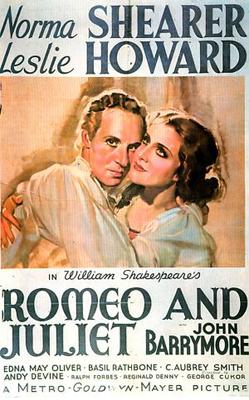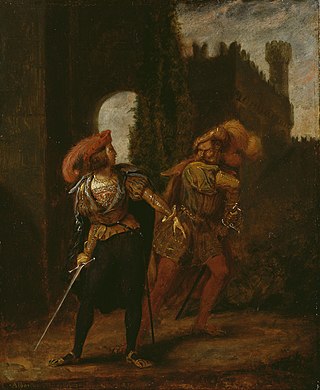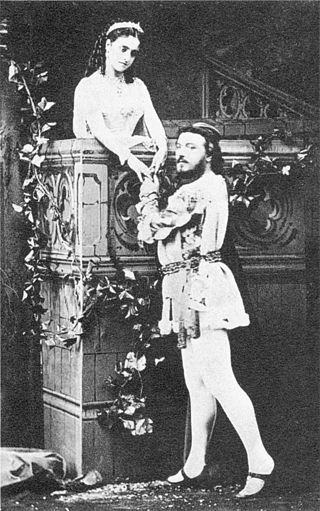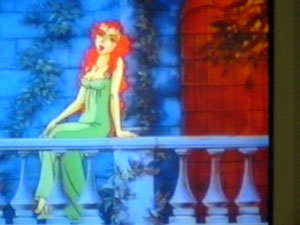
Romeo and Juliet is a tragedy written by William Shakespeare early in his career about the romance between two Italian youths from feuding families. It was among Shakespeare's most popular plays during his lifetime and, along with Hamlet, is one of his most frequently performed. Today, the title characters are regarded as archetypal young lovers.

Romeo and Juliet is a 1968 period romantic tragedy film, based on the play of the same name by William Shakespeare. Directed and co-written by Franco Zeffirelli, the film stars Leonard Whiting as Romeo and Olivia Hussey as Juliet. Laurence Olivier spoke the film's prologue and epilogue and dubs the voice of Antonio Pierfederici, who played Lord Montague but was not credited on-screen. The cast also features Milo O'Shea, Michael York, John McEnery, Bruce Robinson, and Robert Stephens.

Romeo and Juliet is a 1936 American film adapted from the play by William Shakespeare, directed by George Cukor from a screenplay by Talbot Jennings. The film stars Leslie Howard as Romeo and Norma Shearer as Juliet, and the supporting cast features John Barrymore, Basil Rathbone, and Andy Devine.

Tybalt is a character in William Shakespeare's play Romeo and Juliet. He is the son of Lady Capulet's brother, Juliet's short-tempered first cousin, and Romeo's rival. Tybalt shares the same name as the character Tibert / Tybalt "the prince of cats" in the popular story Reynard the Fox, a point of mockery in the play. Mercutio repeatedly calls Tybalt "prince of cats", in reference to his sleek, yet violent manner.

Mercutio is a fictional character in William Shakespeare's 1597 tragedy, Romeo and Juliet. He is a close friend to Romeo and a blood relative to Prince Escalus and Count Paris. As such, Mercutio is one of the named characters in the play with the ability to mingle around those of both houses. The invitation to Lord Capulet's party states that he has a brother named Valentine.
Sir Matthew Christopher Bourne is a British choreographer. His productions contain many classic cinema and popular culture references and draw thematic inspiration from musicals, film noir and popular culture

Romeo and Juliet, Op. 64, is a ballet by Sergei Prokofiev based on William Shakespeare's play Romeo and Juliet. First composed in 1935, it was substantially revised for its Soviet premiere in early 1940. Prokofiev made from the ballet three orchestral suites and a suite for solo piano.

Roméo et Juliette is an opera in five acts by Charles Gounod to a French libretto by Jules Barbier and Michel Carré, based on Romeo and Juliet by William Shakespeare. It was first performed at the Théâtre Lyrique, Paris on 27 April 1867. This opera is notable for the series of four duets for the main characters and the waltz song "Je veux vivre" for the soprano.
Roméo et Juliette: de la Haine à l'Amour is a French musical based on William Shakespeare's play Romeo and Juliet, with music and lyrics by Gérard Presgurvic. It premiered in Paris on January 19, 2001. The production was directed and choreographed by Redha, with costumes by Dominique Borg and settings by Petrika Ionesco. The producers were Gérard Louvin, GLEM, and Universal Music. ! Since then, the musical has been performed in Verona, Rome, Canada, Antwerp, London, Amsterdam, Budapest, Szeged, Moscow, Vienna, Bucharest, Seoul, Pusan, Taipei, Monterrey, Japan, Hong Kong, Shanghai and Portugal and has been translated into several languages, including Dutch, Italian, Hungarian, Russian, English, German, Spanish, Romanian, Japanese, Korean, Portuguese, and Slovak.
A ghost character, in the bibliographic or scholarly study of texts of dramatic literature, is a term for an inadvertent error committed by the playwright in the act of writing. It is a character who is mentioned as appearing on stage, but who does not do anything, and who seems to have no purpose. As Kristian Smidt put it, they are characters that are "introduced in stage directions or briefly mentioned in dialogue who have no speaking parts and do not otherwise manifest their presence". It is generally interpreted as an author's mistake, indicative of an unresolved revision to the text. If the character was intended to appear and say nothing, it is assumed this would be made clear in the playscript.
Romeo.Juliet is a 1990 film-in-concert adaptation of William Shakespeare's tragedy Romeo and Juliet. The motion picture is an original creation by American director, producer, writer and cinematographer Armando Acosta. With a cast of feral cats from Venice, New York City, Verona and Ghent, the dialogue is vocalized by award-winning British film and theater talent. The soundtrack features Sergei Prokofiev's Romeo and Juliet ballet music.

William Shakespeare's Romeo and Juliet may be one of the most-screened plays of all time. The most notable theatrical releases were George Cukor's multi-Oscar-nominated 1936 production Romeo and Juliet, Franco Zeffirelli's 1968 film Romeo and Juliet, and Baz Luhrmann's 1996 MTV-inspired Romeo + Juliet. The latter two were both, at the time, the highest-grossing Shakespeare films. Cukor featured the mature actors Norma Shearer and Leslie Howard as the teenage lovers while Zeffirelli populated his film with beautiful young people, and Baz Luhrmann produced a heavily cut fast-paced version aimed at teenage audiences.
William Shakespeare's play Romeo and Juliet, set in Verona, Italy, features the eponymous protagonists Romeo Montague and Juliet Capulet. The cast of characters also includes members of their respective families and households; Prince Escalus, the city's ruler, and his kinsman, Count Paris; and various unaffiliated characters such as Friar Laurence and the Chorus. In addition, the play contains two ghost characters and an unseen character (Rosaline).
West Side Story Suite is a ballet suite choreographed by Jerome Robbins. Robbins conceived, directed and choreographed the 1957 musical West Side Story, then co-directed its 1961 film adaptation, before including parts of the choreography in the anthology Jerome Robbins' Broadway. Robbins developed the latter to the ballet West Side Story Suite for the New York City Ballet, which premiered on May 18, 1995, at the New York State Theater.
Choreographer Sir Kenneth MacMillan's Royal Ballet production of Sergei Prokofiev's Romeo and Juliet premiered at the Royal Opera House, Covent Garden on 9 February 1965.
Edward Clug is a choreographer in the field of contemporary ballet born in Romania

Romeo & Juliet is a 2013 film adaptation of William Shakespeare's romantic tragedy. Written by Julian Fellowes and directed by Carlo Carlei, it stars Douglas Booth, Hailee Steinfeld, Damian Lewis, Kodi Smit-McPhee, Ed Westwick, Stellan Skarsgård and Paul Giamatti. The film opened in the United Kingdom and the United States on 11 October 2013. While remaining faithful to the original plot, it uses only some of the dialogue written by Shakespeare. This has led to several critics denouncing the film on the grounds that it loses the essence of the play. The film grossed $3 million.
People's Romeo is a play by British playwright Mukul Ahmed based on William Shakespeare's Romeo and Juliet.
Rudolf Nureyev's production of Sergei Prokofiev's Romeo and Juliet premiered at the London Coliseum on 2 June 1977.







